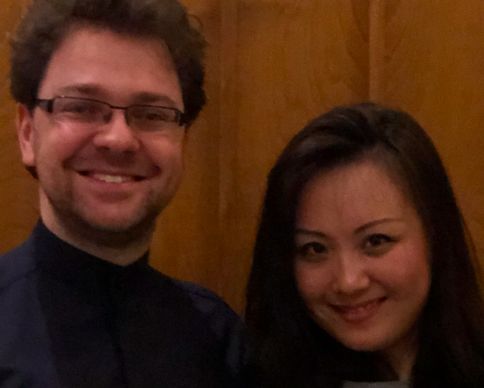|
Chamber
FAMILIAR AND NEW - TRIO NAVARRO'S SPRING CONCERT IN WEILL
by Terry McNeill
Sunday, April 21, 2024
Symphony
MONUMENTAL MAHLER 5TH IN SO CO PHIL'S SEASON ENDING CONCERT
by Terry McNeill
Sunday, April 14, 2024
Chamber
OAKMONT SEASON CLOSES WITH STRAUSS' PASSIONATE SONATA
by Terry McNeill
Thursday, April 11, 2024
Chamber
MORE GOLD THAN KORN AT ALEXANDER SQ CONCERT
by Terry McNeill
Sunday, April 7, 2024
Choral and Vocal
VIBRANT GOOD FRIDAY REQUIEM AT CHURCH OF THE ROSES
by Pamela Hicks Gailey
Friday, March 29, 2024
TWO OLD, TWO NEW AT THE SR SYMPHONY'S MARCH CONCERT IN WEILL
by Peter Lert
Saturday, March 23, 2024
Chamber
NOT A SEVENTH BUT A FIRST AT SPRING LAKE VILLAGE CONCERT
by Terry McNeill
Wednesday, March 20, 2024
THIRTY-THREE PLUS VARIATIONS AND AN OCEAN VIEW
by Terry McNeill
Saturday, March 16, 2024
Choral and Vocal
A ST. JOHN PASSION FOR THE AGES
by Abby Wasserman
Friday, March 8, 2024
Choral and Vocal
SPLENDID SCHUBERT SONGS IN SANET ALLEN RECITAL
by Terry McNeill
Saturday, March 2, 2024
|
 |
 Alexander Sitkovetsky and Wu Qian At Mill Valley Recital (C. Lowenthal Photo) |
ECLECTIC VIOLIN AND PIANO WORKS IN VIRTUOSIC MILL VALLEY RECITAL
by Abby Wasserman
Sunday, February 23, 2020
Blending virtuosity with sublime artistry, violinist Alexander Sitkovetsky and pianist Wu Qian gave the Mill Valley Chamber Music Society audience many thrills February 23, performing four muscular and soulful works by four composers from four countries: de Falla, Schumann, Stravinsky, and Grieg. The clear, balanced acoustics of Mt. Tamalpais Methodist Church were ideal for this intimate music.
Their program opened with de Falla’s Siete Canciones Populares Españolas, written in 1914 for soprano and piano, but here in the transcription by violinist Paul Kochanski, who worked closely with de Falla to transcribe six of the seven. Each song is a mini-masterpiece representing a different style and region of Spain. All deal with the vicissitudes of love, and stir up the soul. The duo’s reading was magnetic. Mr. Sitkovetsky’s rich sonorities were burnished, almost as though he was playing the viola or even a cello, and Ms. Qian’s pianism was equally beautiful. The musicians immersed the large audience in the Spanish spirit.
The mood turned from Spanish passion to agitated exuberance in Schumann’s Sonata No. 2 in D minor, Op. 121. Mr. Sitkovetsky moved a second music stand next to the first, explaining to the audience, “No rests,” for there is literally no place in the score for the violinist to take a musical rest in the first movement. Strongly bowed slashes of rising and falling notes lent the movement a feeling of urgency and discomfort. The intensity never let up, with offset rhythms speaking of yearning and inner turmoil.
The sonata was premiered by Clara Schumann and Josef Joachim. It’s dedicated to violinist Ferdinand David, and employs the musical triad D-A-F-D in the violin and piano parts. Near the end of the second movement a chorale melody from the last movement of Mendelssohn’s Piano Trio in C Minor makes its way into the music. Mendelssohn had died four years earlier and this may have been Schumann’s memorial tribute. The tender third movement Romanza, written in the Spanish style, had an extended and lovely pizzicato progression which was then lyrically taken up by the piano. Mr. Sitkovetsky’s double-note technique here and throughout the concert was exciting, as were Ms. Qian’s piano arpeggios, now slow, now lightning-swift. The fourth movement, harkening back to themes of the first movement, was played as a race with time.
Following intermission the artists returned with Stravinsky’s Suite Italienne from his ballet Pulcinella. There are six movements in the suite, which Stravinsky called “My discovery of the past, the epiphany through which the whole of my late works became possible.” He wrote it for orchestra and subsequently for violin and piano (two versions) and cello and piano. The suite is alternately mournful, ironic, edgy, and joyful, evoking endless images and scenes: a thicket of birdsong; a Scottish dance; baby chicks hopping about; a fox creeping toward a henhouse; a lumbering bear; a shimmering sky. It was a exciting performance first to last.
Ms. Qian’s golden, warm sound, deft legato pedaling and the lightness of her trills cast a spell.
The final work in the evening was Grieg’s splendid Sonata for Violin and Piano in C minor, Op. 45. Although imbued with national feeling, this is not just national music, as it’s heavy with shadow and buoyant with hope, and this performance touched all the emotions. It has inexpressibly sweet lyrical sections, and sections where all aspirations were plunged into shadow, and throughout, intimations of mysterious forces seemingly were at work. It was a masterful performance of the middle movement Romanza.
When the duo finished the Grieg, the audience jumped up to applaud them. After three curtain calls, the artists took the stage again to play a show stopping czardas from 1904 by Vittorio Monti. Before beginning, Mr. Sitkovetsky confided from the stage that he had first played the piece at the age of 12. The duo then launched into gypsy mode with dramatic rubatos and breakneck speed for a boffo finish.
|

